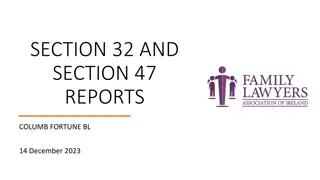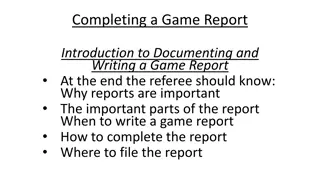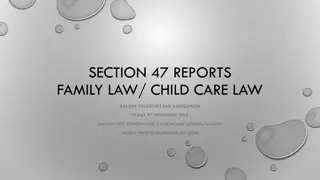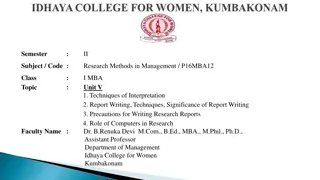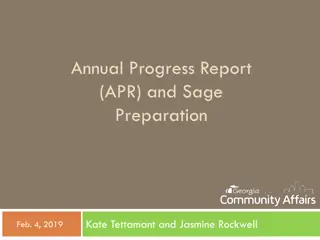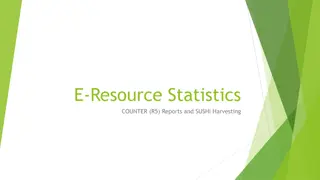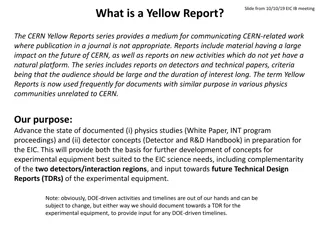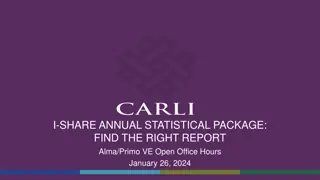Understanding the Structure of Research Reports
A research report consists of several key sections such as the preliminary part, introduction, literature review, methodology, data analysis, results, conclusions, and bibliography. The preliminary part includes components like cover, title, preface, acknowledgement, table of contents, list of tables, and list of graphs. The introduction sets the background and problem statement, while the literature review explores existing research. The methodology details the research approach, data collection, and analysis methods. Understanding these sections is essential for writing effective research reports.
Download Presentation

Please find below an Image/Link to download the presentation.
The content on the website is provided AS IS for your information and personal use only. It may not be sold, licensed, or shared on other websites without obtaining consent from the author. Download presentation by click this link. If you encounter any issues during the download, it is possible that the publisher has removed the file from their server.
E N D
Presentation Transcript
Structure of a report Structure of a report Concluding Remarks Results Bibliography The Research Methodology Review of Literature Introduction of the Report Preliminary Part Findings Books review Introduction Processing of data Cover Title Preface Acknowledgem ent The theoretical framework (variables) Appendices Review of articles published in books, journals, periodicals, etc Conclusions Background of the research study Hypothesis / model testing Shortcomings Model / hypothesis Review of articles published in leading newspapers Suggestions to the problems Statement of the problem Data analysis and interpretation Table of contents Instruments for data collection Working papers / discusssion paper / study reports Direction for further research Brief outline of the chapters List of tables Tables and figures Data collection List of graphs Articles on authorised websites
Preliminary Part The preliminary part may have seven major components cover, title, preface, acknowledgement, table of contents, list of tables, list of graphs. Long reports presented in book form have a cover made up of a card sheet. The cover contains title of the research report, the authority to whom the report is submitted, name of the author, etc. The preface introduces the report to the readers. It gives a very brief introduction of the report. In the acknowledgements author mention names of persons and organisations that have extended co-operation and helped in the various stages of research. Table of contents is essential. It gives the title and page number of each chapter.
Introduction of the Report The introduction of the research report should clearly and logically bring out the background of the problem addressed in the research. The purpose of the introduction is to introduce the research project to the readers. A clear statement of the problem with specific questions to be answered is presented in the introduction. It contains a brief outline of the chapters.
Review of Literature The third section reviews the important literature related to the study. A comprehensive review of the research literature referred to must be made. Previous research studies and the important writings in the area under study should be reviewed. Review of literature is helpful to provide a background for the development of the present study. The researcher may review concerned books, articles published in edited books, journals and periodicals. Researcher may also take review of articles published in leading newspapers. A researcher should study working papers/discussion papers/study reports. It is essential for a broad conclusion and indications for further research.
The Research Methodology Research methodology is an integral part of the research. It should clearly indicate the universe and the selection of samples, techniques of data collection, analysis and interpretation, statistical techniques, etc.
Results Results contain pilot study, processing of data, hypothesis/model testing, data analysis and interpretation, tables and figures, etc. This is the heart of the research report. If a pilot study is planned to be used, it s purpose should be given in the research methodology. The collected data and the information should be edited, coded, tabulated and analysed with a view to arriving at a valid and authentic conclusion. Tables and figures are used to clarify the significant relationship. The results obtained through tables, graphs should be critically interpreted.
Concluding Remarks The concluding remarks should discuss the results obtained in the earlier sections, as well as their usefulness and implications. It contains findings, conclusions, shortcomings, suggestions to the problem and direction for future research. Findings are statements of factual information based upon the data analysis. Conclusions must clearly explain whether the hypothesis have been established and rejected. This part requires great expertise and preciseness. A report should also refer to the limitations of the applicability of the research inferences. It is essential to suggest the theoretical, practical and policy implications of the research. The suggestions should be supported by scientific and logical arguments. The future direction of research based on the work completed should also be outlined.
Bibliography The bibliography is an alphabetic list of books, journal articles, reports, etc, published or unpublished, read, referred to, examined by the researcher in preparing the report. The bibliography should follow standard formats for books, journal articles, research reports. The end of the research report may consist of appendices, listed in respect of all technical data. Appendices are for the purpose of providing detailed data or information that would be too cumbersome within the main body of the research report.










